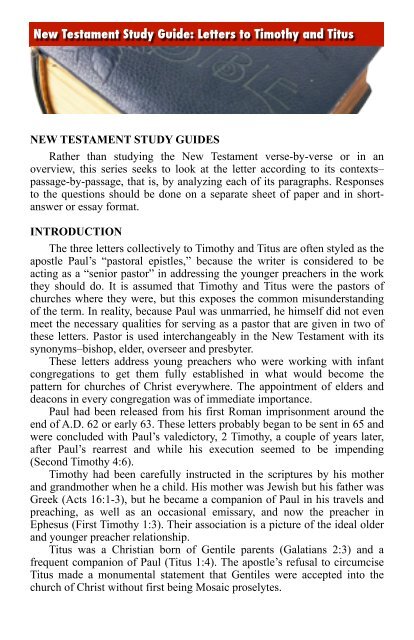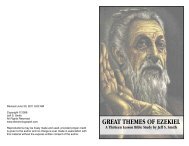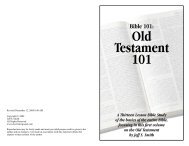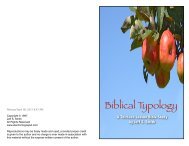New Testament Study Guides - ElectronicGospel
New Testament Study Guides - ElectronicGospel
New Testament Study Guides - ElectronicGospel
Create successful ePaper yourself
Turn your PDF publications into a flip-book with our unique Google optimized e-Paper software.
<strong>New</strong> <strong>Testament</strong> <strong>Study</strong> Guide: Letters to Timothy and Titus<br />
NEW TESTAMENT STUDY GUIDES<br />
Rather than studying the <strong>New</strong> <strong>Testament</strong> verse-by-verse or in an<br />
overview, this series seeks to look at the letter according to its contexts–<br />
passage-by-passage, that is, by analyzing each of its paragraphs. Responses<br />
to the questions should be done on a separate sheet of paper and in shortanswer<br />
or essay format.<br />
INTRODUCTION<br />
The three letters collectively to Timothy and Titus are often styled as the<br />
apostle Paul’s “pastoral epistles,” because the writer is considered to be<br />
acting as a “senior pastor” in addressing the younger preachers in the work<br />
they should do. It is assumed that Timothy and Titus were the pastors of<br />
churches where they were, but this exposes the common misunderstanding<br />
of the term. In reality, because Paul was unmarried, he himself did not even<br />
meet the necessary qualities for serving as a pastor that are given in two of<br />
these letters. Pastor is used interchangeably in the <strong>New</strong> <strong>Testament</strong> with its<br />
synonyms–bishop, elder, overseer and presbyter.<br />
These letters address young preachers who were working with infant<br />
congregations to get them fully established in what would become the<br />
pattern for churches of Christ everywhere. The appointment of elders and<br />
deacons in every congregation was of immediate importance.<br />
Paul had been released from his first Roman imprisonment around the<br />
end of A.D. 62 or early 63. These letters probably began to be sent in 65 and<br />
were concluded with Paul’s valedictory, 2 Timothy, a couple of years later,<br />
after Paul’s rearrest and while his execution seemed to be impending<br />
(Second Timothy 4:6).<br />
Timothy had been carefully instructed in the scriptures by his mother<br />
and grandmother when he a child. His mother was Jewish but his father was<br />
Greek (Acts 16:1-3), but he became a companion of Paul in his travels and<br />
preaching, as well as an occasional emissary, and now the preacher in<br />
Ephesus (First Timothy 1:3). Their association is a picture of the ideal older<br />
and younger preacher relationship.<br />
Titus was a Christian born of Gentile parents (Galatians 2:3) and a<br />
frequent companion of Paul (Titus 1:4). The apostle’s refusal to circumcise<br />
Titus made a monumental statement that Gentiles were accepted into the<br />
church of Christ without first being Mosaic proselytes.









